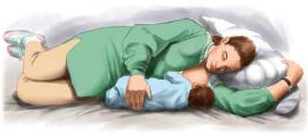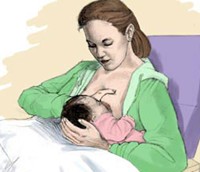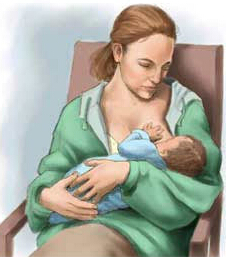It is a common misconception among mothers who undergo C-section that they cannot breastfeed their babies. But multiple studies reveal that women who deliver with the help of cesarean can breastfeed as successful as those who give birth vaginally, so long as the mother shows real commitment. However, it is true that milk production and ejection occurs early in a mother who undergoes spontaneous delivery because of all the hormonal pulses stimulated during the process.
Benefits of Breastfeeding After C-Section
Many mothers-to-be anticipate the miracle of vaginal birth with an eager heart, and when deprived of the opportunity, disappointment is an expected reaction. But what they need to understand is that delivering the baby by C-section by no means deprives them of the beautiful experience of nursing. In fact, it just might be more important for these mothers to nurse their babies sooner in order to stimulate their milk production.
As a mother holds her baby close to herself, the tiny human recognizes and responds to her touch, which brings equal satisfaction to the pair. Moreover, as the baby suckles at the mother’s breast, it not only reinforces the infant’s suckling reflex, but also increases the release of hormone oxytocinin the mother’s body. This brings about milk ejection and helps to tone the uterine muscles, thus reducing the risk of uterine bleeding after giving birth. Each baby born has a right to the earliest breast milk which is rich in antibodies and immune cells that has no substitute.
When to Start Breastfeeding After C-Section
No time is sooner to start breastfeeding after a C-section. The mother and child should have a skin-to-skin contact soon after birth, which helps to regulate the baby’s body temperature. It is advised to put the baby to breast as soon as possible, preferably in the first hour following birth. Studies show that this haste helps increase the milk production and makes lactation easier by decreasing the discomfort associated with breast engorgement. It also provides the mothers who undergo C-section with the benefit of distraction, so that for some time they are kept from feeling the pain at incision site. The timing is so important that even if the mother cannot sit up, she is still encouraged to put the baby to her breast while lying down, or to ask the help of her partner or the nursing staff. If none of these is possible, the mother can always use breast pump to pump the breast milk, which can be given to the baby in a milk bottle.
Breastfeeding Positions
Mothers who undergo C-section might find nursing their babies a bit more difficult, especially right after surgery when lying flat on her back with IV lines secured on her arms. Another problem is the incision site, which might be pressured in different positions of breastfeeding after C-section. To avoid such problems, the following positions are recommended:
- Side lying position

This may be the best position in which the mother lies on her side, a pillow behind her to support her back, and a towel or two under the knees to help reduce the strain that the position might put on her lower abdomen that bears the incision. A small pillow can be put across the incision as well, in order to prevent any accidents that might occur as the baby moves. The baby should be placed so that he/she directly faces the mother’s breast and does not have to turn to reach the nipple.
- Football hold position

Also known as the “clutch hold” because in this position the mother holds her baby just the way a clutch is held under the arm. The baby’s head is supported with a hand and he/she is held with the face against mother’s breast, feet reaching her elbow/armpit on the same side. This position eliminates the risk of any accidental pressure or injury to the mother’s incision site. This position too can be made more comfortable with the help of towels and pillows for extra support.
- Cradle hold

This position is found not as comfortable as the football hold in the beginning by many mothers, but becomes more comfortable after the first few days of recovery from the cesarean.
More Things to Bear in Mind
- How much to breastfeed: When it comes to breastfeeding after C-section, it is important to pay attention to baby’s milk requirements. Baby should be breastfed every 2 hours during the day, and not be kept hungry for over 4 hours during the night. It is highly recommended that in early weeks, your baby should get 10-20 feedings in 24 hours. If a mother is nursing properly and the baby is getting sufficient milk, no other supplementation is required like formula or sugar-water.
- In the hospital, it is better to get information in advance regarding rooming-in after the C-section, as extra help from your partner and family members will be needed for taking care of the baby. If there is an option for private room, it will be a good idea to avail it. Many hospitals now allow the baby to stay with his/her mother most of the time, while others keep the baby under observation for 24 hours in nursery after C-section.
- Always plan beforehand for the extra help you will need back home. After the C-section, it will not be easy for the mother to take care of all the chores at home like housework, taking care of the older kids, lifting the newborn. It is best to have someone from your family or friends to assist in such condition during the first couple of weeks.
Effect of Medications
Infants are not seriously affected by the medications administered to the mother during C-section. Moms usually receive epidural (regional anesthesia). Some newborns get sleepy after epidural, though it does not affect their development or ability to start breastfeeding after C-section. Very little of regional anesthesia gets into bloodstream, but if you are given general anesthesia, it is fine to breastfeed the baby as soon as you wake up properly.
After C-section, initially pain killer are given intravenously and later tablets are prescribed to make you comfortable. Very little of these medicines enter the milk and might only make the baby drowsy. Oxytocin hormone is responsible for milk production after birth of the baby. Feeling of pain interferes with this hormone; so it is important to control the pain post-partum. Always talk to your doctor regarding such issue.
